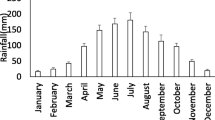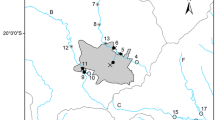Abstract
The Ruoergai (Zoige) Wetland, the largest plateau peatland in the world, is located in the Yellow River source region. The discharge of the Yellow River increases greatly after flowing through the Ruoergai Wetland. The aquatic ecosystem of the Ruoergai Wetland is crucial to the whole Yellow River basin. The Ruoergai wetland has three main kinds of water bodies: rivers, oxbow lakes, and marsh wetlands. In this study, macroinvertebrates were used as indicators to assess the aquatic ecological status because their assemblage structures indicate long-term changes in environments with high sensitivity. Field investigations were conducted in July, 2012 and in July, 2013. A total of 72 taxa of macroinvertebrates belonging to 35 families and 67 genera were sampled and identified. Insecta was the dominant group in the Ruoergai Basin. The alpha diversity of macroinvertebrates at any single sampling site was low, while the alpha diversity on a basin-wide scale was much higher. Macroinvertebrate assemblages in rivers, oxbow lakes, and marsh wetlands differ markedly. Hydrological connectivity was a primary factor causing the variance of the bio-community. The river channels had the highest alpha diversity of macroinvertebrates, followed by marsh wetlands and oxbow lakes. The density and biomass of Gastropoda, collector filterers, and scrapers increased from rivers to oxbow lakes and then to marsh wetlands. The river ecology was particular in the Ruoergai Wetland with the high beta diversity of macroinvertebrates, the low alpha diversity of macroinvertebrates, and the low taxa richness, density, and biomass of EPT (Ephemeroptera, Plecoptera, Trichoptera). To maintain high alpha diversity of macroinvertebrates macroinvertebrates in the Ruoergai Wetland, moderate connectivity of oxbow lakes and marsh wetlands with rivers and measures to control headwater erosion are both crucial.
Similar content being viewed by others
References
Amoros C, Bornette G (2002). Connectivity and biocomplexity in waterbodies of riverine floodplains. Freshw Biol, 47(4): 761–776
Amoros C, Roux A (1988). Interaction between water bodies within the floodplains of large rivers: function and development of connectivity. In: Schreiber K F, ed. Connectivity in Landscape Ecology. Munster, 125–130
Bai J H, Lu Q Q, Wang J J, Zhao Q Q, Ouyang H, Deng W, Li A N (2013). Landscape pattern evolution processes of alpine wetlands and their driving factors in the Zoige plateau of China. J Mt Sci, 10(1): 54–67
Barbour M T, Gerritsen J, Snyder B D (1999). Benthic macroinvertebrate protocols. In: Barbour M T, Gerritsen J, Snyder B D, Stribling J B, eds. Rapid Bioassessment Protocols for Use in Streams and Wadeable Rivers: Periphyton, Benthic Macroinvertebrates and Fish. EPA 841-B-99-002. Washington: U.S. Environmental Protection Agency, 7.1–7.20
Beisel J N, Usseglio-Polatera P, Moreteau J C (2000). The spatial heterogeneity of a river bottom: a key factor determining macroinvertebrate communities. In: Jungwirth M, Muhar S, Schmutz S, eds. Assessing the Ecological Integrity of Running Waters. Springer Netherlands, 163–171
Braak C T, Smilauer P (2002). CANOCO Reference Manual and User’s Guide to Canoco for Windows: Software for Canonical Community Ordination (Version 4.5). Microcomputer Power: Ithaca, New York, USA
Dai Y, Luo Y, Wang C K, Shen Y P, Ma Z F, Wang X L (2010). Climate variation and abrupt change in wetland of Zoige Plateau during 1961 and 2008. Journal of Glaciology and Geocryology, 32(1): 35–42 (in Chinese)
Dong Z B, Hu G Y, Yan C Z, Wang W L, Lu J F (2010). Aeolian desertification and its causes in the Zoige Plateau of China’s Qinghai-Tibetan Plateau. Environ Earth Sci, 59(8): 1731–1740
Downes B J, Lake P, Schreiber E, Glaister A (2000). Habitat structure, resources and diversity: the separate effects of surface roughness and macroalgae on stream invertebrates. Oecologia, 123(4): 569–581
Duan X H, Wang Z Y, Xu M Z (2010). Benthic Macroinvertebrates and Application in the Assessment of Stream Ecology. Beijing: Tsinghua University Press, 1–168 (in Chinese)
Gallardo B, García M, Cabezas Á, González E, González M, Ciancarelli C, Comín F A (2008). Macroinvertebrate patterns along environmental gradients and hydrological connectivity within a regulated river-floodplain. Aquat Sci, 70(3): 248–258
Hu G Y, Dong Z B, Lu J F, Yan C Z (2012). Driving forces of land use and land cover change (LUCC) in the Zoige Wetland, Qinghai-Tibetan Plateau. Sci Cold Arid Reg, 4(5): 422–430
Huo L, Chen Z, Zou Y, Lu X, Guo J, Tang X (2013). Effect of Zoige alpine wetland degradation on the density and fractions of soil organic carbon. Ecol Eng, 51: 287–295
Junk W J, Bayley P B, Sparks R E (1989). The flood pulse concept in river-floodplain systems. Can J Fish Aquat Sci, 106(1): 110–127
Kefford B J (1998). The relationship between electrical conductivity and selected macroinvertebrate communities in four river systems of south-west Victoria, Australia. Int J Salt Lake Res, 7(2): 153–170
Lessard J L, Hayes D B (2003). Effects of elevated water temperature on fish and macroinvertebrate communities below small dams. River Res Appl, 19(7): 721–732
Li Z W, Wang Z Y, Zhang C D, Han L J, Zhao N (2014). A study on the mechanism of wetland degradation in Ruoergai swamp. Advances in Water Science, 25(2): 172–180 (in Chinese)
Obolewski K (2011). Macrozoobenthos patterns along environmental gradients and hydrological connectivity of oxbow lakes. Ecol Eng, 37 (5): 796–805
Pan B Z, Wang H J, Liang X M, Wang H Z (2011). Macrozoobenthos in Yangtze floodplain lakes: patterns of density, biomass, and production in relation to river connectivity. J N Am Benthol Soc, 30(2): 589–602
Pan B Z, Wang Z Y, Xu M Z (2012). Macroinvertebrates in abandoned channels: assemblage characteristics and their indications for channel management. River Res Appl, 28(8): 1149–1160
Pringle C (2003). What is hydrologic connectivity and why is it ecologically important? Hydrol Processes, 17(13): 2685–2689
Qiu P F, Wu N, Luo P, Wang Z Y, Li M H (2009). Analysis of dynamics and driving factors of wetland landscape in Zoige, Eastern Qinghai-Tibetan Plateau. J Mt Sci, 6(1): 42–55
Reckendorfer W, Baranyi C, Funk A, Schiemer F (2006). Floodplain restoration by reinforcing hydrological connectivity: expected effects on aquatic mollusc communities. J Appl Ecol, 43(3): 474–484
Salo J, Kalliola R, Häkkinen I, Mkinen Y, Niemelä P, Puhakka M, Coley P D (1986). River dynamics and the diversity of Amazon lowland forest. Nature, 322(6076): 254–258
Shannon C E, Weaver W (1948). A mathematical theory of communication. American Telephone and Telegraph Company
Smith M, Kay W, Edward D, Papas P, Richardson K S J, Simpson J, Pinder A, Cale D, Horwitz P, Davis J, Yung F H, Norris R H, Halse S A (1999). AusRivAS: using macroinvertebrates to assess ecological condition of rivers in Western Australia. Freshw Biol, 41(2): 269–282
Steinberg C E W, Kamara S, Prokhotskaya V Y, Manusadžianas L, Karasyova T A, Timofeyev M A, Jie Z, Paul A, Meinelt T, Farjalla V F, Matsuo A Y O, Burnison B K, Menzel R (2006). Dissolved humic substances-ecological driving forces from the individual to the ecosystem level? Freshw Biol, 51(7): 1189–1210
Tang J, Xu Q R, Wang L M, Ding X, Tang B, Wu L S, Feng S, Sun Q, Yang Z R, Zhang J (2011). Soil bacterial community diversity under different stages of degradation in zoige wetland. Microbiology, 38(5): 677–686 (in Chinese)
Tang T, Qu X, Li D, Liu R, Xie Z, Cai Q (2004). Benthic algae of the Xiangxi River, China. J Freshwat Ecol, 19(4): 597–604
Tockner K, Malard F, Ward J V (2000). An extension of the flood pulse concept. Hydrol Processes, 14(16-17): 2861–2883
Vannote R L, Minshall G W, Cummins K W, Sedell J R, Cushing C E (1980). The river continuum concept. Can J Fish Aquat Sci, 37(1): 130–137
Wang Z Y, Lee J H W, Melching C S (2012). River Dynamics and Integrated River Management. Berlin and Beijing: Springer
Wang Z Y, Melching C S, Duan X H, Yu G (2009). Ecological and hydraulic studies of step-pool systems. J Hydraul Eng, 135(9): 705–717
Ward J V, Stanford J A (1995). The serial discontinuity concept: extending the model to floodplain rivers. Regul River, 10(2-4): 159–168
Ward J V, Tockner K, Schiemer F (1999). Biodiversity of floodplain river ecosystems: ecotones and connectivity. Regul River, 15(1-3): 125–139
Water and Waste Water Monitoring and Analysis Method Committee (WWWMAMC) (2002). Water and Waste Water Monitoring and Analysis Method (4th ed). Beijing: China Environmental Science Press (in Chinese)
Wu P F, Yang D X (2011). Effect of habitat degradation on soil mesoand microfaunal communities in the Zoige Alpine Meadow, Qinghai-Tibetan Plateau. Acta Ecol Sin, 31(13): 3745–3757 (in Chinese)
Xiao D R, Tian B, Tian K, Yang Y (2010). Landscape patterns and their changes in Sichuan Ruoergai wetland national nature reserve. Acta Ecol Sin, 30(1): 27–32
Xu M Z, Wang Z Y, Duan X H, Pan B Z (2014). Effects of pollution on macroinvertebrates and water quality bio-assessment. Hydrobiologia, 729(1): 247–259
Yan Y J, Liang Y L (1999). A study of dry-to-wet weight ratio of aquatic macroinvertebrates. Journal of Huazhong University of Science & Technology, 27(9): 61–63 (in Chinese)
Zhang H Z, Wu P F, Yang D X, Cui L W, He X J, Xiong Y Q (2011a). Dynamics of soil meso-and microfauna communities in Zoige alpine meadows on the eastern edge of Qinghai-Tibet Plateau, China. Acta Ecol Sin, 31(15): 4385–4397 (in Chinese)
Zhang X Y, Lu X G, Gu H J (2005). To analysis threats, to describe present conservation situation and to provide management advices of the Ruoergai Marshes. Wetland Science, 3(4): 292–297 (in Chinese)
Zhang Y, Wang G, Wang Y (2011b). Changes in alpine wetland ecosystems of the Qinghai-Tibetan plateau from 1967 to 2004. Environ Monit Assess, 180(1-4): 189–199
Zhao N, Wang Z Y, Pan B Z, Xu MZ, Li ZW (2015). Macroinvertebrate assemblages in mountain streams with different streambed stability. River Res Appl, 31(7): 825–833
Zhou W, Lu X, Wu Z, Deng L, Jull A T, Donahue D, Beck W (2002). Peat record reflecting Holocene climatic change in the Zoig Plateau and AMS radiocarbon dating. Chin Sci Bull, 47(1): 66–70
Acknowledgements
This study was financially supported by the Key Research Project of the Higher Education Institutions of Henan Province (16A416002), the Doctoral Scientific Research Foundation of Henan University of Science and Technology (13480017), the National Natural Science Foundation of China (Grant No. 91547112), the Foundation of the Yellow River Institute of Hydraulic Research (No. HKY-JBYW-2016-03), and the International Science & Technology Cooperation Program of China (2014DFG72010).
Author information
Authors and Affiliations
Corresponding authors
Rights and permissions
About this article
Cite this article
Zhao, N., Xu, M., Li, Z. et al. Macroinvertebrate distribution and aquatic ecology in the Ruoergai (Zoige) Wetland, the Yellow River source region. Front. Earth Sci. 11, 554–564 (2017). https://doi.org/10.1007/s11707-016-0616-x
Received:
Accepted:
Published:
Issue Date:
DOI: https://doi.org/10.1007/s11707-016-0616-x




